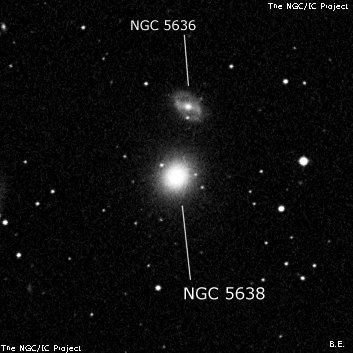
William Herschel discovered NGC 5638 = H II-581 = h1817, along with II-580 = NGC 5636, on 30 Apr 1786 (sweep 558) and recorded "Two, the place is that of the most south [NGC 5638]. pB, gbM, pL, R. The most north NGC 5636] distance about 2'. eF, cL, requiring much attention to be seen."
400/500mm - 17.5" (6/8/91): bright, moderately large, slightly elongated 5:4 NW-SE, 1.5'x1.2', increases to a very small very bright core containing a stellar nucleus. Forms an unusual pair with low surface brightness NGC 5636 1.9' NNW. UGC 9277, situated 18' WNW, appeared faint, small, edge-on 5:1 SW-NE, very small weak concentration.
600/800mm - 24" (6/27/14): bright, large, very slightly elongated NNW-SSE, 1.8'x1.5'. There are three very distinct brightness zones. The central region was sharply concentrated with a very bright core containing an intensely bright, quasi-stellar nucleus. The halo was fairly uniform and only dimmed at the edges. NGC 5638 is the brightest in a trio with NGC 5636 2' NNW and much fainter UGC 9310 5' ESE. UGC 9310 appeared very faint, fairly small, elongated NNW-SSE, ~0.6'x0.25', surprisingly low surface brightness. Extends generally north of a mag 13 star (double with a mag 14.7 star 20" SW) at the south end, which detracts from viewing. Another mag 13 star (very close double) is 1.3' N.
Notes by Steve Gottlieb